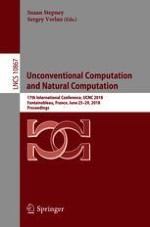This book constitutes the proceedings of the 17th International Conference on Unconventional Computation and Natural Computation, UCNC 2018, held in Fontainebleau, France, in June 2018.
The 15 full papers presented were carefully reviewed and selected from 22 submissions. The paper cover topics such as hypercomputation; chaos and dynamical systems based computing; granular, fuzzy and rough computing; mechanical computing; cellular, evolutionary, molecular, neural, and quantum computing; membrane computing; amorphous computing, swarm intelligence; artificial immune systems; physics of computation; chemical computation; evolving hardware; the computational nature of self-assembly, developmental processes, bacterial communication, and brain processes.
